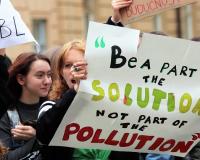
Vibrant Environment
Environmental Justice
All | Biodiversity | Climate Change and Sustainability | Environmental Justice | Governance and Rule of Law | Land Use and Natural Resources | Oceans and Coasts | Pollution Control

Climate change threatens to dramatically increase inequality and create greater hardships for women and girls, in large part because of their disproportionately vulnerable economic, social, and political positions worldwide. Food shortages disproportionately affect the health of women and girls, and in many regions, women are more directly dependent on natural resources threatened by climate change for their livelihoods. For instance, a U.N. report observed that in developing countries, women account for 45-80% of all food production, and about two-thirds of the female labor force is engaged in agricultural work. In such developing regions, women face unique vulnerabilities from the increasing unpredictability of food sources as well as the loss of income or jobs if agricultural resources are impacted by climate change.

When’s the last time you found yourself idly shopping out of boredom or buying a shirt just because it was on sale? If it was in the last week, then you’re not alone. The average American shopper buys 60% more clothing today than they did just 15 years ago, but keeps it for only half as long. At the end of the year, this results in approximately 80 pounds of unwanted clothing per person!

Several cases before the U.S. Supreme Court this term touched environmental law, ranging from jurisdictional disputes over a state’s right to ban uranium mining to whether state or federal laws apply when hunting moose from a hovercraft along an Alaskan river. An unusual amount of cases navigate the intersection of environmental regulations and tribal sovereignty, the Court so far siding with tribes on the issues of state fuel tax exemptions and hunting rights. One pending case, Carpenter v. Murphy, is not explicitly environmental, but the answer to its core question has potentially seismic environmental implications: is the eastern half of Oklahoma still, technically, an Indian reservation? While the case primarily involves criminal jurisdiction, the degree to which the Court accepts or rejects this question may alter taxation, regulation, and even ownership of one of the most energy resource-rich regions in the country.

With climate change actively intensifying impacts from natural disasters, it is now more important than ever to design and implement community resilience plans and actions that will minimize damage when disasters occur. To prepare for an increasingly uncertain and fraught future, communities are identifying vulnerabilities, planning for forthcoming disasters, and taking action to become more resilient. But what exactly does resilience mean? What does it mean to be a resilient community? And, importantly, is there a concrete way to measure a community’s progress toward resilience as it is defined by the community so that its members can ensure they are taking appropriate steps to be better able to respond to a new normal?

Women have been leaders in every major movement, though their contributions all too often go unrecognized. The environmental movement is no exception. Women striving toward the betterment of this field have faced many challenges, but through skill and determination, they persevered. The environmental movement is over two centuries long with generations of women shaping policies and laws within the field. This blog features just a handful of the numerous women who paved the way for future environmentally conscious generations.

Many have argued that gender equality and women’s empowerment are essential to advancement in many areas of life, such as business, health, and education. This brief blog post posits that the field of sustainable development and environmental protection are no different. Gender equality and, more particularly, women’s empowerment, are critical to achieving sustainable development across the globe. It is not a one-size-fits-all proposition, and the gender differences and deeply rooted policies that perpetuate inequality differ from region to region.

In the shadows of the Potomac River, the Anacostia River has long been known as D.C.’s forgotten river due to the effects of heavy pollution and neglect. With recent efforts to remediate the river, the Anacostia and its surrounding neighborhoods are a site of urban development and environmental gentrification.

The famous Cuyahoga River fire of June 22, 1969 — the spur that started debate on pollution across the nation, and led to passage of the Clean Water Act three years later — is lodged more in legendary storytelling than in reality. The fire was actually fairly minor, causing only $50,000 in losses to the Republic Steel Mill located along the river, damaging some wooden trestles. Moreover, no photograph of the event exists — the photo reproduced here, like the one a month later in Time magazine, was from a much larger 1952 blaze.

Following the recently granted extension, the United Kingdom (U.K.) will soon trigger Article 50, officially “Brexitting” from the European Union (EU), a decision that will fundamentally change the U.K. and the wider EU. Protesters—many of them young—have mobilized in London, in Westminster, and across the U.K. to express concern about how this move out of the EU will affect their future. Nearly 6 million people, dominated by young voices, have signed a petition to revoke Article 50. Similarly, students and youth worldwide have joined “climate strikes” in a unified call for concerted action on global climate change. Are these widespread protests a harbinger of social change and action on climate, driven by the younger generation?

March 16, 2019; a young whale is found washed up on a beach in the Philippines. Autopsy reveals the whale died from “gastric shock” after ingesting 40kg of plastic rubbish including plastic bags and other disposable plastic products. Three weeks later, a pregnant sperm whale is found dead on a beach in Sardinia, Italy, more than two-thirds of her stomach filled with plastic waste.
These whales are the latest casualties of a growing worldwide plastic pollution problem.